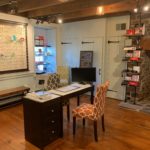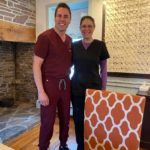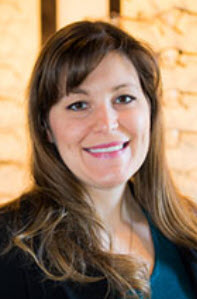
Dr. Richard’s optical. Dr. Richard says a few practice improvements has transformed her ability to serve patients and grow profitability.
By Melissa Richard, OD
Oct. 26, 2022
I’m always looking for ways to improve care for our patients and profitability for our practice. Here are a few improvements we made that changed the care our patients receive from us while allowing us to also become more profitable.
Purchased Automated Refraction System
I needed to furnish my second exam room, and wanted to try an automated phoropter. We were just returning at that point from the pandemic shutdown. I was excited because I could operate an automated refraction system from six feet away from the patient behind the phoropter. The patient could pull their mask down if the lenses were fogging up and we would still be socially distanced.
I met with my Marco representative for a practice analysis. He looked at my patient flow, current equipment and my EHR integration. He presented me with the best package at the time (fortunately for me there was a COVID special), but each OD needs to meet with their own reps to find what’s best for them and their practice.
Editor’s note: There are many automated refraction systems to choose from such companies as Topcon Healthcare, Visionix and Reichert, among other options.
I chose not to do another manual phoropter because the cost between the automated phoropter and the manual version was incremental considering the value gained with the automated version. It really cost me no time to implement the new system. My rep installed the equipment in the morning and it was up and running in the afternoon. It was easy to learn for both me as the refractionist and my techs as the screeners.
Patients are impressed with the technology of the automated refraction. They perceive they are getting a better, more thorough exam. We save time by not having to dial the patient’s Rx into the phoropter and not having to transcribe the results after the refraction. It also eliminates transcription errors.
The best and most unexpected benefit of my automated refraction system is the button that allows me to show the patient their new refraction versus what is in their current glasses (or unaided, if they don’t already wear glasses). Patients who ordinarily wouldn’t purchase new glasses are now getting them because they got to see the difference with a press of a button in the exam room.
Results: We are seeing a 30 percent increase in patients updating their glasses due to this new technology. The time savings per patient is also helpful. It gives me time to discuss the newer treatments and services we offer.
Started Prescribing & Selling Contoured Prism Glasses
In November 2018, 2.5 years into my cold-start practice, we added the Neurolens measurement device to provide a solution to our patients’ mostly undiagnosed binocular vision issues.
I wanted to differentiate my practice by providing a service and solution that could not be offered online or by the big-box stores.
I partnered with Neurolens and started what is now known as “The Neurolens Process.” The first step was to start screening my patients with the Lifestyle Index, provided by Neurolens. This seven-question survey allows me to identify patients who may be suffering from digital vision syndrome or other underlying binocular vision issues. It can be done in the office or online prior to their exam.
Other Articles to Explore
The second step was to add the Neurolens measurement device to my practice, and then to measure the symptomatic patients (according to the lifestyle index results) to find the patients who would benefit. The measurement takes 2-3 minutes and was incorporated into our pretesting protocol.
The last step is offering the solution, contoured prism glasses. We already have an optical in our practice, so I just had to open an account with the lab that makes Neurolens glasses.
The only cost was the cost of the measurement device. You must have the device in order to prescribe the lenses. I financed my device. With my financing, I had to sell two pairs of Neurolenses per month to make my payment. This did not include my frame profit or money I made on medical office visits for follow-ups. I have never had a problem selling more than two pairs a month, even though my practice was still pretty small when we first started selling them.
Patients are extremely impressed with the technology. Even if they aren’t a candidate for the Neurolens themselves, they ask about the testing, why it was done and end up referring their friends, neighbors, or family members, to be tested. For those who are symptomatic, the testing results help me explain to the patient what is going on. It is difficult for someone to see that a patient with binocular vision issues is suffering because they don’t look any different. The results of the Neurolens measurement device testing helps to validate these patients’ symptoms, and they appreciate having a doctor who goes above and beyond to identify the problem.
These glasses are life-changing. Symptom relief is 80-90 percent for headaches, neck pain, discomfort with computer use, dizziness, light sensitivity and dry eye sensation. A recent study even shows that Neurolenses increases patients’ reading speed and productivity.
Results: My profitability has gone up every month since adding Neurolens. These glasses now make up about 20 percent of my optical sales. The lenses are not covered by vision plans, so it is all self-pay. I also get many word-of-mouth referrals from patients wearing Neurolens glasses, which has helped me grow my patient base.

Dr. Richard with Paul B. Johnson, MD, the oculoplastic surgeon who works out of her office, enabling many patients to stay in her practice for care.
Added Oculoplastic Services
I hired an oculoplastic surgeon in May 2020, right after the two-month pandemic shutdown. We were talking about doing this before the shutdown, but with the pandemic, it got put on hold.
I wanted to be able to refer blepharoplasty surgery candidates in-house. With a growing practice, we are going to see more patients who want/need blepharoplasty. I also like being able to keep lid lesions and papillomas in house. Most of all, I was excited to offer aesthetic optometry services to my patients, such as Botox and fillers.
The oculoplastic surgeon already rotated through other offices. He wanted to expand into our area to serve an unmet need. We figured out a compensation package that worked for both of us. I purchased all of the instruments/equipment/consumables he needed using a list he provided (forceps, sutures, gauze, drapes, lidocaine, dexamethasone, autoclave, ice packs, etc). I also had to purchase the Botox and fillers to get us started.
I had to train my staff on how to work with him and prepare for his in-office procedures. I also had to train a staff member to do the prior authorizations for surgeries that were done at the surgery center. I had to learn how to do all the surgery billing. Luckily we already do a lot of medical billing, so the learning curve wasn’t too steep.
I spent around $6,000 on initial supplies/instruments/etc. The pandemic shutdown gave me free time at home to search for the best pricing on what I needed to purchase. I found most things I needed on Amazon and Eye Care and Cure. I also realized I had to furnish my second exam room with a slit lamp and reclining exam chair. I went with a nice refurbished slit lamp and chair for that room. The reclining chair is perfect for the surgeon’s in-office procedures.
Patients love that they can stay in-house for papillomas and lid lesions and for blepharoplasty consults. We keep information on Botox and fillers at the front desk, so everyone knows about the additional services we offer. Staff members have gotten Botox and fillers themselves, which also helps open up the conversation. Patients are happy to have procedures done here because they trust us with their eyes.
Results: There is so much demand in our office for our oculoplastic surgeon’s services that we have increased his hours from two to four times per month. We take in an additional 10 percent in revenues each month from him being in the office just four half-days.
I recommend that other practices interested in adding oculoplastic services start slow, or plan ahead, so you can keep your surgeon’s schedule busy.
 Melissa Richard, OD, MS, is the owner of Spectrum Vision in Chalfont, Penn. To contact her: mrichard@spectrumvision.com
Melissa Richard, OD, MS, is the owner of Spectrum Vision in Chalfont, Penn. To contact her: mrichard@spectrumvision.com





















